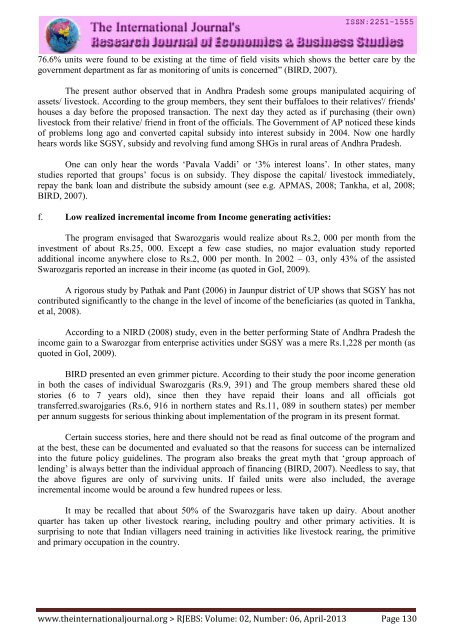Research Journal of Economics & Business Studies - RJEBS - The ...
Research Journal of Economics & Business Studies - RJEBS - The ...
Research Journal of Economics & Business Studies - RJEBS - The ...
- No tags were found...
Create successful ePaper yourself
Turn your PDF publications into a flip-book with our unique Google optimized e-Paper software.
76.6% units were found to be existing at the time <strong>of</strong> field visits which shows the better care by the<br />
government department as far as monitoring <strong>of</strong> units is concerned” (BIRD, 2007).<br />
<strong>The</strong> present author observed that in Andhra Pradesh some groups manipulated acquiring <strong>of</strong><br />
assets/ livestock. According to the group members, they sent their buffaloes to their relatives'/ friends'<br />
houses a day before the proposed transaction. <strong>The</strong> next day they acted as if purchasing (their own)<br />
livestock from their relative/ friend in front <strong>of</strong> the <strong>of</strong>ficials. <strong>The</strong> Government <strong>of</strong> AP noticed these kinds<br />
<strong>of</strong> problems long ago and converted capital subsidy into interest subsidy in 2004. Now one hardly<br />
hears words like SGSY, subsidy and revolving fund among SHGs in rural areas <strong>of</strong> Andhra Pradesh.<br />
One can only hear the words ‘Pavala Vaddi’ or ‘3% interest loans’. In other states, many<br />
studies reported that groups’ focus is on subsidy. <strong>The</strong>y dispose the capital/ livestock immediately,<br />
repay the bank loan and distribute the subsidy amount (see e.g. APMAS, 2008; Tankha, et al, 2008;<br />
BIRD, 2007).<br />
f. Low realized incremental income from Income generating activities:<br />
<strong>The</strong> program envisaged that Swarozgaris would realize about Rs.2, 000 per month from the<br />
investment <strong>of</strong> about Rs.25, 000. Except a few case studies, no major evaluation study reported<br />
additional income anywhere close to Rs.2, 000 per month. In 2002 – 03, only 43% <strong>of</strong> the assisted<br />
Swarozgaris reported an increase in their income (as quoted in GoI, 2009).<br />
A rigorous study by Pathak and Pant (2006) in Jaunpur district <strong>of</strong> UP shows that SGSY has not<br />
contributed significantly to the change in the level <strong>of</strong> income <strong>of</strong> the beneficiaries (as quoted in Tankha,<br />
et al, 2008).<br />
According to a NIRD (2008) study, even in the better performing State <strong>of</strong> Andhra Pradesh the<br />
income gain to a Swarozgar from enterprise activities under SGSY was a mere Rs.1,228 per month (as<br />
quoted in GoI, 2009).<br />
BIRD presented an even grimmer picture. According to their study the poor income generation<br />
in both the cases <strong>of</strong> individual Swarozgaris (Rs.9, 391) and <strong>The</strong> group members shared these old<br />
stories (6 to 7 years old), since then they have repaid their loans and all <strong>of</strong>ficials got<br />
transferred.swarojgaries (Rs.6, 916 in northern states and Rs.11, 089 in southern states) per member<br />
per annum suggests for serious thinking about implementation <strong>of</strong> the program in its present format.<br />
Certain success stories, here and there should not be read as final outcome <strong>of</strong> the program and<br />
at the best, these can be documented and evaluated so that the reasons for success can be internalized<br />
into the future policy guidelines. <strong>The</strong> program also breaks the great myth that ‘group approach <strong>of</strong><br />
lending’ is always better than the individual approach <strong>of</strong> financing (BIRD, 2007). Needless to say, that<br />
the above figures are only <strong>of</strong> surviving units. If failed units were also included, the average<br />
incremental income would be around a few hundred rupees or less.<br />
It may be recalled that about 50% <strong>of</strong> the Swarozgaris have taken up dairy. About another<br />
quarter has taken up other livestock rearing, including poultry and other primary activities. It is<br />
surprising to note that Indian villagers need training in activities like livestock rearing, the primitive<br />
and primary occupation in the country.<br />
www.theinternationaljournal.org > <strong>RJEBS</strong>: Volume: 02, Number: 06, April-2013 Page 130

















